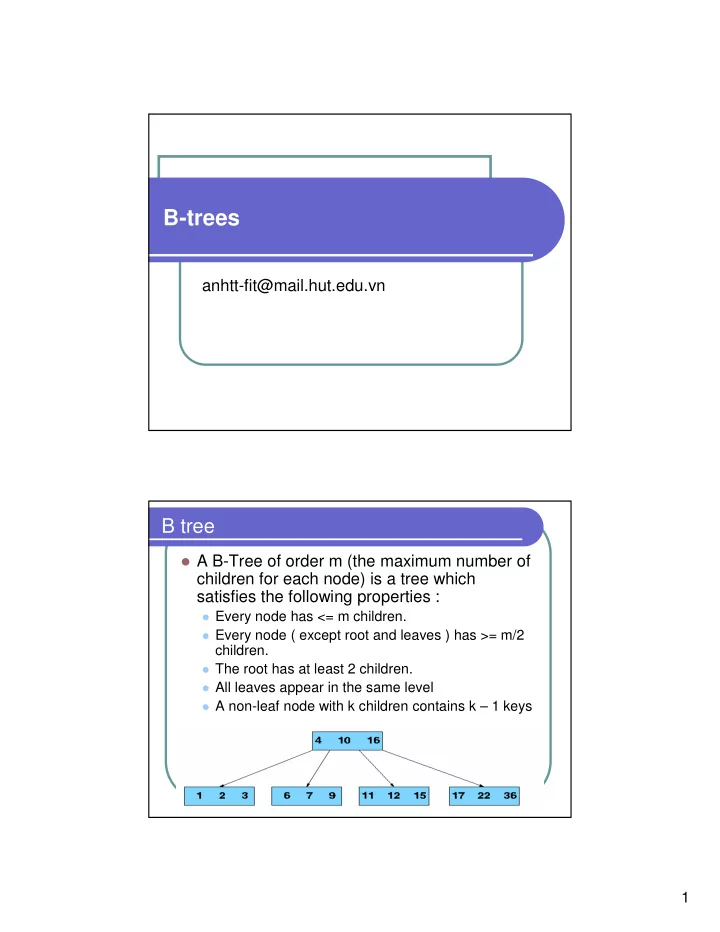

B-trees anhtt-fit@mail.hut.edu.vn B tree � A B-Tree of order m (the maximum number of children for each node) is a tree which satisfies the following properties : � Every node has <= m children. � Every node ( except root and leaves ) has >= m/2 children. � The root has at least 2 children. � All leaves appear in the same level � A non-leaf node with k children contains k – 1 keys 1
B-Tree � Generalizes 2-3-4 trees by allowing up to M links per node. � Main application: file systems. � Reading a page into memory from disk is expensive. � Accessing info on a page in memory is free. � Goal: minimize # page accesses. � Node size M = page size. � Space-time tradeoff. � M large ! only a few levels in tree. � M small ! less wasted space. � Number of page accesses is log M N per op. � Typical M = 1000, N < 1 trillion. Example � TELSTRA: customer billing database with 51 billion rows, 4.2 terabytes of data. � Databases cannot be maintained entirely in memory, b-trees are often used to index the data and to provide fast access. 2
Search B-Tree in the wild � Red-black trees: widely used as system symbol tables � Java: java.util.TreeMap, java.util.TreeSet. � C++ STL: map, multimap, multiset. � Linux kernel: linux/rbtree.h. � B-Trees: widely used for file systems and databases � Windows: HPFS. � Mac: HFS, HFS+. � Linux: ReiserFS, XFS, Ext3FS, JFS. � Databases: ORACLE, DB2, INGRES, SQL, PostgreSQL � All nodes in B-Tree are assumed to be stored in secondary storage (disk) rather than primary storage (memory), � There basic operations for accessing a page: Disk- Read(), Disk-Write(), Allocate-Node() 3
B-Tree Library � Software and documentation is accessed at http://www.hydrus.org.uk/doc/bt/html/index.ht ml Notes � Initiate the library #include "btree.h“ int btinit (void); � The B Tree is stored in a UNIX disk file. The file can contain many B Trees, each of which is referred to by a name assigned by the user (or application). 4
API � Creating a B Tree File BTA* btcrt(char* fid , int nkeys , int shared ); � Opening a B Tree File BTA* btopn(char* fid , int mode , int shared ); � Closing a B Tree File int btcls(BTA* btact ); � BTA : BT activation context API (cont.) � Inserting a key and data int btins(BTA* btact , char* key , char* data , int dsize ); � Updating data for an existing key int btupd(BTA* btact , char* key , char* data , int dsize ); � Locating data for an existing key int btsel(BTA* btact , char* key , char* data , int dsize , int* rsize ); � Deleting a key and associated data int btdel(BTA* btact , char* key ); � Locating data for the next key in sequence int btseln(BTA* btact , char* key , char* data , int dsize , int* rsize ); 5
Building and installing the BT Library � Unpack the tar file into a convenient directory. $cd <bt library> $make clean $make � Make built an UNIX static library libbt.a , a BT test harness bt , and a utility, kcp , which performs intelligent copies of BT index files. Quiz 1 � Install and compile BT Library in your machine � Run BT test harness to verify if successful installed � See documentation at http://www.hydrus.org.uk/doc/bt/html/ch05.htm 6
Quiz 2 � Use the BT library to write a phone book program that manipulates data on the secondary disk. Another library for B-Tree � Download at http://www.mycplus.com/utilitiesdetail.asp?iPro= 10 � This library allow specifying different comparison functions for keys. 7
Mini project 1 � Make a program to manage a computer dictionary � Add/Search/Delete a word (using B-Tree) � Auto complete search. Ex. When we enter “comput” and <tab>, the word “computer” should be auto completed (like Shell) � Suggestion search => Use soundex library � Build two programs using the two BT library respectively. � Test the performance of the two programs with a dictionary of millions words (the words can be randomly created) � Test for the two basic operations: search and insert � Project in group of 3-4 persons 8
Recommend
More recommend